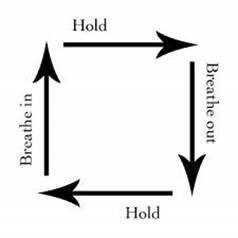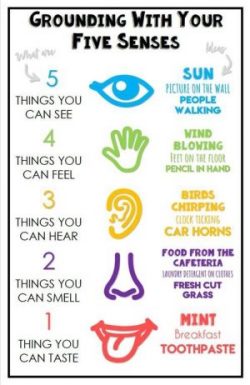When things feel overwhelming or uncertain it can be useful to use some relaxation and stress management tools to help you manage your emotions. They can help you understand what is going on in your mind and body.
Finding ways to relax that work for you can help you to manage your worries better. It can also improve your sleep and help with some of the physical symptoms that can come with stress, such as headaches or sore stomachs.
It is important to notice and recognise when your body is telling you it is feeling stress. People can experience this differently but some of the common signs are below:

Take a moment to think about what your body is telling you when you are stressed. These are your early warning signs that things are getting tricky and that you might need to use calming strategies.
Here is a video from Mind with some great ideas of ways to relax. Choose what works for you as there is no right way to do it!
Some relaxation tools need a bit of practice. Don’t give up if it doesn’t work to begin with! Keep trying and you should start to see the benefits.
Before you get started, it is good to find a quiet space where you are less likely to be disturbed. Try and find 20-30 minutes to focus if you can, but even 5 minutes can be helpful.
Breathing techniques
One of the main tools for managing stress and anxiety are breathing techniques. There are many different types of breathing exercises that you could do and you can find a simple breathing exercise on the NHS website

3-4-5 Breathe
This exercise can be very effective for helping with anxiety or stress. It’s very simple. Breathe in for three seconds, hold for four seconds and breathe out for five seconds. When you breathe out for longer than you breathe in, you reduce the signs of being in a stress state i.e. you slow your heart down, reduce the ‘sweaty palms’ feeling etc. and encourage your body to get back in a position where it can manage better.
Younger children should not hold their breath so they should just breathe out for longer than they breathe in for e.g. breathe in for four counts, breath out for six counts.
Progressive muscle relaxation
This teaches you to relax your muscles through a two-step process. First, you deliberately apply tension to certain muscle groups, then you stop the tension and turn your attention to noticing how the muscles relax as the tension flows away. It is a great technique for reducing overall body tension.
What to do:
- Lie down or sit with your back straight and your feet on the floor. Close your eyes or focus on a spot in the distance.
- Begin by tensing all the muscles in your face. Make a tight grimace, close your eyes as tightly as possible, clench your teeth, even move your ears up if you can. Hold this for the count of eight as you breath in.
- Now breath out, and relax completely. Let your face go completely slack, as though you were sleeping. Feel the tension melt from your facial muscles, and enjoy and notice the difference between the 2 feelings.
- Next, completely tense your neck and shoulders, again taking a breath in and counting to eight. Then breath out and relax.
- Continue down your body, repeating the procedure with all the different muscle groups. Take time to notice any parts of your body that feel tense, tight or tired. You can repeat if you still feel tense. For the shortened version, just include the four main muscle groups: Face, Neck, shoulders and arms, Stomach and chest, Bottom, legs and feet.
- Take a moment to relax, then slowly and gently begin to move. When you feel ready, you can stand up slowly.
- For younger children, these relaxation scripts are an easier way to work on these skills – you might find that you prefer these too!
Mindfulness
Mindfulness is a technique you can learn which involves making a special effort to notice what’s happening in the present moment (in your mind, body and surroundings) – without judging anything. See these great tips on mindfulness from Mind for more information and ideas.
Calm have produced a webpage with lots of useful free resources such as calming music, movement exercises, soundscapes and sleep meditations. There are resources especially for children too.
Mindfulness is not for everyone and some can find it quite intense so if you feel it is not working for you and even making things worse, then stop and look at other strategies instead.
Grounding techniques
When people feel really overwhelmed, at times it can be useful to use what are called Grounding Techniques. These involve trying to calm the brain and the body by reconnecting to the world around you, for the times when we can flip our lid (see below a video about what happens when your brain gets overwhelmed):
When you are feeling overwhelmed, it can be helpful to focus on the sensations you are feeling right now. An example of a grounding technique called 5, 4, 3, 2, 1 is included below.
Online courses and apps
Living Life To The Full have now made their Young People online programme FREE. This excellent resource has great strategies to help us make sense and cope at this difficult time. The programme helps you learn key life skills that can give you a growing sense of control over how you feel and how you react.
The NHS also list a number of apps related to mental health. Some are free to download and the website gives an idea of what each app is for.
CAMHS (Child and Adolescent Mental Health Service) Grampian created some podcast called Keep CAMHS and carry on. It included top tips from staff about managing stress in tough times.
When things get too big
It is normal to be feeling anxious, confused, frustrated and upset from time to time. However If you were struggling with your mental health it is okay to ask for more help.

There are lots of mental health organisations with a wealth of information:
- SAMH have created an online hub for mental health and Covid19
- Young minds
- Mind
- See Me Scotland’s programme to tackle mental health stigma and discrimination
- Young Scot
It might help to plan a ‘safe space’ in your home that you’ll go to when you are feeling particularly overwhelmed, or a self soothe box with things that can help you to feel more grounded and relaxed.
If you’re worried about something, talk to an adult that you trust as soon as possible.
If you are not sure who to talk to there are lots of services that can help.
- Samaritans is open 24/7. You can call them on 116 123 or email them at jo@samaritans.org.
- Give us a SHOUT also provide a free text service 24/7 for people feeling anxious, worried or stressed. Just text 85258.
- Breathing Space is open 6pm to 2am, Monday – Thursday, and 24 hours a day on the weekends (Friday 6pm to Monday 6am). You can call them on 0800 83 85 87. If you are a British Sign Language user you can contact them via their online BSL-interpreting video relay service (VRS).
- Childline is open 9am-midnight. You can call them 0800 1111. They also have an online service where you can chat with a counsellor about whatever’s worrying you.
Online Services available in Aberdeenshire
There are also now two free online services available in Aberdeenshire. The provision of these commissioned services is part of joint working between Aberdeenshire Council, Aberdeenshire Health and Social Care Partnership, Police Scotland, NHS Grampian and third sector partners including Aberdeenshire Voluntary Action in a GIRFEC Mental Health Group. Kooth is open to those aged 10-18 while Togetherall is for everyone 16+ meaning that online mental health support is now available to children and young people as well as adults across Aberdeenshire every day of the week.
Kooth 
Kooth (10 to 18 year age group) also provide 1:1 sessions with counsellors and emotional wellbeing practitioners available via drop-in or booked appointment which helps to reduce waiting times for young people seeking help, removing stigma around mental health. This service can be accessed by young people directly by registering at www.kooth.com Support is also available to schools and staff supporting children and young people by emailing aberdeenshire@kooth.com
Togetherall 
Togetherall (16+ age group) will help to bridge between youth and adult services with appropriate mental wellbeing support. Trained and accredited professionals are available 24/7 to support the community members and there’s a choice of safe therapeutic services, including courses, self-assessments and wellbeing resources to improve your mental health. This means anyone who may be struggling can get support at a time that suits them, from a place of their choice. The Togetherall community is completely anonymous. This service can be accessed by inputting your postcode under the ‘My area is registered’ link at www.togetherall.com and creating a completely anonymous user account.


